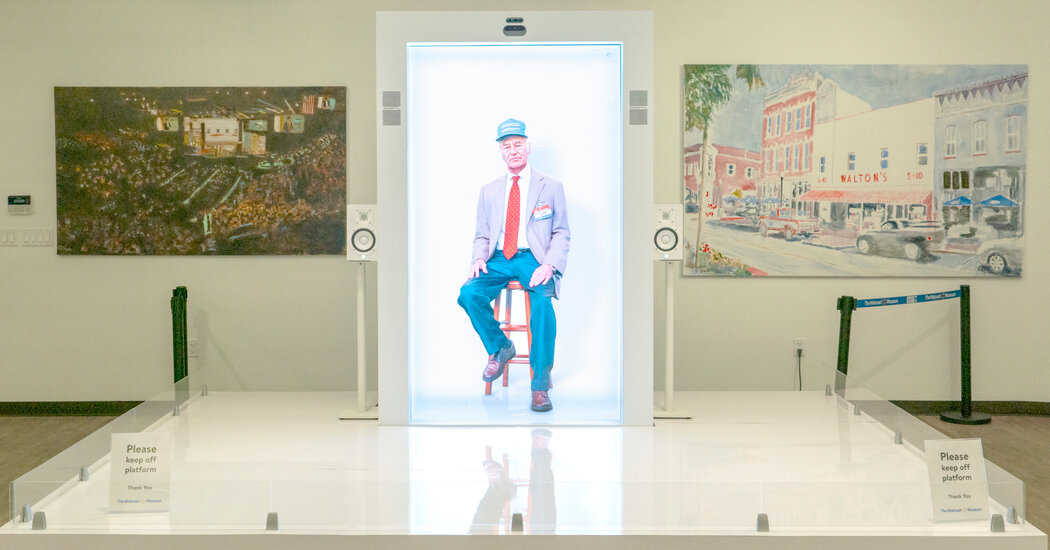On a stormy afternoon in Bentonville, Ark., a Walmart regional manager recounted a story about a moment when his humanity came up short.
He was 24-year-old store manager anxiously trying to get his workers to set up Halloween merchandise displays. Instead, the workers were gathered around the televisions in the electronics department. It was the morning of Sept. 11, 2001.
“Why are we over here not setting up Halloween? Why is it not done yet?” he recalled saying. He didn’t fully understand what was happening until a worker tearfully laid into him, explaining that she had relatives in New York City.
“I didn’t take a minute to survey the room to understand the ramifications of my words and my actions,” the former store manager, David Seymore, now a regional vice president at Walmart, told his listeners. “I grew up really fast that day.”
His remarks were meant as an object lesson. Mr. Seymore, who now manages 110 stores in the South and the Midwest doing $11 billion in annual business, was speaking to a group of Walmart and Sam’s Club store managers who had come to Walmart headquarters for a leadership-training program that has taken place nearly every week at the retailer since July 2022.
Walmart and Sam’s Club store managers run multimillion-dollar enterprises and manage hundreds of workers. Their ability to drive sales has a direct effect on the company’s revenue, which totaled $648.1 billion last year worldwide.
But the company says their management style matters, too. Most weeks, Walmart flies a group of 50 from across the country — about 1,800 last year in all, with 2,200 expected this year — to what it calls its Manager Academy.
Throughout the sessions, trainers reinforce the message that Walmart’s success is possible only if the store managers take care of their workers and the customers and community where they operate.
“The intent of the academy is to walk away knowing what are our values, what are our expectations of leaders, how do we operate effectively with the view of putting our people first?” said Donna Morris, Walmart Inc.’s chief people officer.
Over the years, Walmart — the largest private employer in the United States with 1.6 million workers — has been accused of being more focused on the bottom line than the people in its stores. In lawsuits and through unsuccessful union campaigns, Walmart workers have said the company’s business practices have been detrimental to their physical, mental and emotional health.
In a 2022 instance, a worker with a health condition died during her shift when a store was short-staffed and her store manager is said to have told her to “pull herself together” when she asked to go home, according to report in The New Republic.
Ms. Morris declined to comment on that case, but said that “we always have a focus on making sure that our people are the first line of what a manager should think about.”
Walmart isn’t the only company focused on getting its managers to think that way. The focus on compassionate leadership became a notable topic of conversation for companies about two years ago, said Jessica Kriegel, a workplace training consultant who has researched the topic.
“The big insight here is that employees feeling cared for is directly tied to communication,” Ms. Kriegel said. “And the folks who communicate the most with the front line are their supervisors. That’s why frontline supervisors are so critical, because if they’re communicating effectively then the work force feels cared for.”
Most executives at Walmart took part in the predecessor to the Manager Academy, the Walton Institute, which was started in the 1980s. And the training has a wider impact: Many Walmart leaders eventually fan out to other companies in the retail industry.
“That Walton Institute was such an amazing way to immerse in the culture of Walmart being away from home,” said Horacio Barbeito, who spent 26 years with the company. “And then you would come back to your market really filled with a lot of company culture that then you become an ambassador and a catalyst.” He left Walmart in 2022 to run Old Navy, a retailer he views as having a similar objective and corporate values.
John Furner, the chief executive of Walmart U.S. and an Arkansas native whose father also worked at Walmart, began his career as an hourly employee at the retailer in the 1993. As he rose through the ranks, he had training at the Walton Institute. It also focused on corporate culture, but back then, the company was still relatively small and it was feasible to know top leadership.
“You weren’t a number,” Mr. Furner said. “You weren’t just somebody that was supposed to deliver results.”
But especially since the start of the pandemic, store managers have taken on new challenges, navigating shifts between in-store and online purchases, higher worker turnover and sometimes unruly shoppers. And as the company has ballooned, it has become harder to make them feel connected to the corporate mission. Mr. Furner suggested to Walmart’s global chief executive, Doug McMillon, that it was time for the company to bring back an in-person training program for store managers.
During the training, former and current executives speak, including Mr. Furner. (Participants even meet the company’s founder, Sam Walton — kind of. At the company’s heritage museum there is a hologram of Mr. Walton explaining how he used watermelons and donkey rides to initially draw people into stores.) The attendees receive an hourlong tour around headquarters where passing executives stop and chat — and are sometimes peppered with questions about the business.
Things also get specific. Managers take part in breakout sessions about how to make all of their workers, from the mechanics in the car repair department to the overnight shift workers mopping the floors and those restocking apples in the grocery department, feel as if they’re contributing to the bigger corporate mission. They brainstorm how to deal with issues both general (understanding other people’s values) and particular (scheduling snafus).
The program gets store managers thinking not only about what comes next for them, but also about how to keep the people reporting to them engaged and finding other opportunities in the company for them. And at the end of the day, Walmart is in the business of selling, and it measures the effectiveness of this program on that basis.
With “really strong store managers who are purpose-driven and values-driven,” said Lorraine Stomski, who runs Walmart’s learning and leadership programs, “we can drive stronger business results.”
Walmart has also been sweetening the incentives to keep managers motivated and from leaving for other opportunities. This year it has increased pay for its store managers, raising base pay to $128,000, and announced stock grants of as much as $20,000. High-performing Walmart managers now have the ability to earn more than $400,000 a year.
In interviews arranged by Walmart, store managers who took part in the program said they enjoyed the emphasis on corporate culture during the training. Laurice Miller, a 39-year-old store manager at a Sam’s Club in Keller, Texas, who started 20 years ago as an hourly employee and now manages 165 people, said that before she attended in January, she had gotten some feedback from people working for her: They were looking to build a relationship with her.
Since taking part in the program, she said she’s made time for informal chats. (“How was your weekend? What can I do to help?”) “I think those are instrumental when you’re around each other for eight hours, 40 hours a week,” she said.
Daniel Harrelson, a 30-year-old store manager in Fayetteville, Ark., took part in the training in October. He started at Walmart as an hourly employee and was promoted to store manager during the pandemic and oversees 450 workers.
He learned of resources that the company sets aside for workers in need, such as free counseling classes and funds for those dealing with housing crises that could arise from fires or domestic violence. For some of his workers, “Walmart’s usually one of their only steady things that they have,” he said.
There were also lighter elements to the training that help to reinforce the culture to him. Take the meetings that managers hold in the store with their workers. All of those start with a rapturous cheer — a tradition Sam Walton started in the 1970s.
During the pandemic, large meetings were dropped to follow social distancing guidelines. The cheer fell by the wayside, too. But the training, he said, helped him realize how important it was to restore the custom.
“It’s not anything spectacular, but it’s something kind of fun,” he said. “It lightens the mood, and it’s something that Sam Walton did.”




